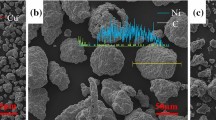Abstract
The joining of tungsten to copper and the ongoing search for commercially viable production techniques is one of the challenging issues in the field of composite materials. The reason why this material combination is of essential importance is its ability to withstand erosion and high temperatures on the tungsten side and to remove big quantities of heat on the copper side. Due to the mismatch of thermal expansion and Young’s moduli, the direct joining of these two materials results in high residual and thermal stresses at the interface, ultimately reducing component lifetime. One potential answer to this problem is functionally graded structures of W and Cu, which smoothen the transition of material properties. The present study focuses on vacuum plasma spraying (120 mbar, Ar) of W/Cu-gradients and composites with defined mixing ratios. The influence of the fabrication process and the W:Cu ratio on the microstructure has been investigated and results from thermo-mechanical and thermo-physical results analyses are presented. Finite element modeling has been used to demonstrate the positive effect of gradients on the elastic and elastic–plastic response within two different model-geometries. Partial gradients, ranging from pure tungsten to 75 vol.% tungsten, exhibit the best results and improve the expected life-time performance significantly by reducing the stresses at both interfaces, W/FGM and FGM/Cu, compared to a reference interface between W and Cu.



















Similar content being viewed by others
References
Brookes KJA (2000) PM Technology Trends, pp 16–18
Joensson M, Kieback B (2001) 15th Int Plansee Seminar, vol 1, RM 3, pp 1–15
Itoh Y, Takahashi M, Hirohisa H (1996) Fus Eng Des 31:279
Hino T, Akiba M (2000) Fus Eng Des 49–50: 97
Ge CC, Zhou ZJ (2005) Mater Sci For 475–479: 1371
Kieback B, Neubrand A, Riedel H (2003) Mater Sci Eng A 362: 81
Birth U, Joensson M, Kieback B (1999) Mater Sci For 308–311: 766
Ge CC, Li JT, Zhou Z-J, Cao W-B, Shen W-P, Wang M-X, Zhang N-M, Liu X, Xu Z-Y (2000) J Nucl Mater 283–287: 1116
Pintsuk G, Brünings SE, Döring J-E, Linke J, Smid I, Xue L (2003) Fus Eng Des 66–68: 259
Gomes UU, da Costa FA, da Silva AGP (2001) 15th Int Plansee Seminar, vol 1, RM 24, pp 177–189
Jedamzik R, Neubrand A, Rödel J (2000) J Mater Sci 35:477
Döring JE, Vaßen R, Pintsuk G, Stöver D (2003) Fus Eng Des 66–68: 259
Wang S-H, Xue L (2005) Surf Eng Mater Sci III: 27
Pintsuk G, Hohenauer W, Linke J, Smid I, Wang S-H, Xue L (2005) 16th Int Plansee Seminar, vol 1, PL11, pp 131–143
Johnson J, German R (2005) 16th Int. Plansee Seminar, vol 1, PL10, pp 116–130
Sabirov I, Pippan R (2005) 16th Int. Plansee Seminar, vol 1, RM28, pp 291–299
Shen W-P, Zhou Z-J, Gu S-Y, Ge C-C, Zhang H, Liu H-L (2005) Mater Sci For 475–479: 1563
Xie J-X, Li S-B, Chen S (2005) Mater Sci For 475–479: 1511
Kang H-K (2004) Scr Mater 51:473
Hamatani H, Shimoda N, Kitaguchi S (2003) Sci Tech Adv Mater 4:197
Shabana YM, Noda N (2001) Comp Part B 32:111
Gasik MM (1998) Comp Mater Sci 13:42
Chapa J, Reimanis I (2002) J Nucl Mater 303:131
Hollis KJ, Castro RG, Doerner RP, Maggiore CJ (2001) Fus Eng Des 55:437
Itoh Y, Andoh H, Suyama S, Shindoh T (2001) J Jpn Inst Met 65(12):1108
Acknowledgements
The supply of W-powders by the Plansee AG and funding by the Austrian “Friedrich Schiedelstiftung für Energietechnik”, which made this project possible, are gratefully acknowledged.
Author information
Authors and Affiliations
Corresponding author
Rights and permissions
About this article
Cite this article
Pintsuk, G., Smid, I., Döring, JE. et al. Fabrication and characterization of vacuum plasma sprayed W/Cu-composites for extreme thermal conditions. J Mater Sci 42, 30–39 (2007). https://doi.org/10.1007/s10853-006-1039-y
Received:
Accepted:
Published:
Issue Date:
DOI: https://doi.org/10.1007/s10853-006-1039-y




